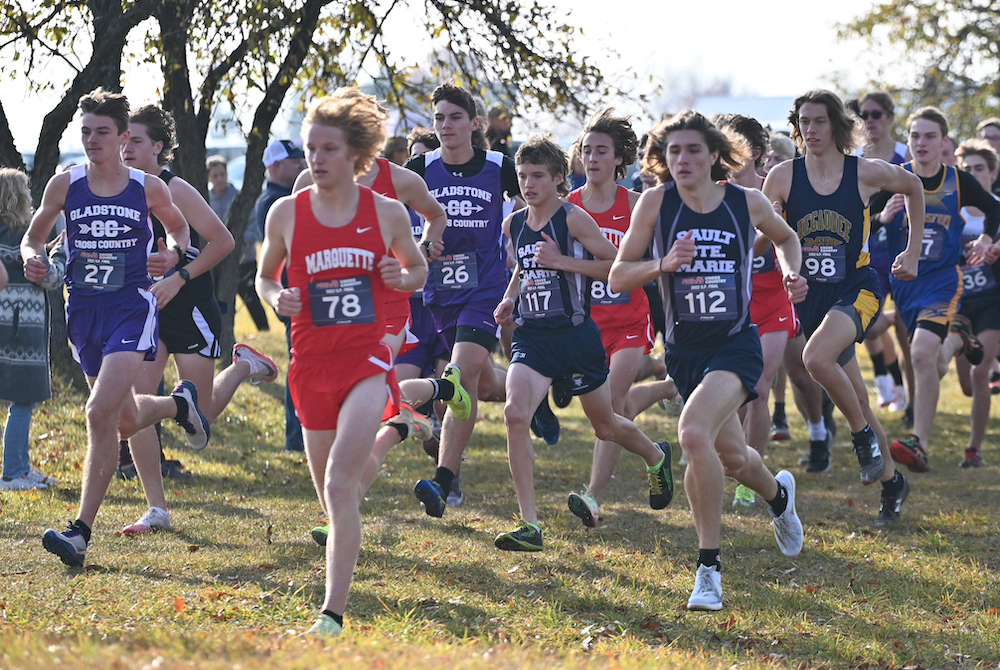
Marquette, Jeffers Repeat While Stephenson Earns 1st Title Since 2012
By
John Vrancic
Special for MHSAA.com
October 22, 2022
FLAT ROCK — It seemed very little, if anything was going to separate the Marquette boys from their fourth straight Upper Peninsula Division 1 cross country title here Saturday.
Despite missing a couple of its top runners, Marquette placed five among the top nine and scored 29 points. They were followed by Sault Ste. Marie with 83 and Houghton at 97.
“The guys push one another and Brady Ketzenberger had a great race,” said Marquette coach Derek Marr. “This envisions the concept of being a team. It’s awesome to see how both teams support each other.”
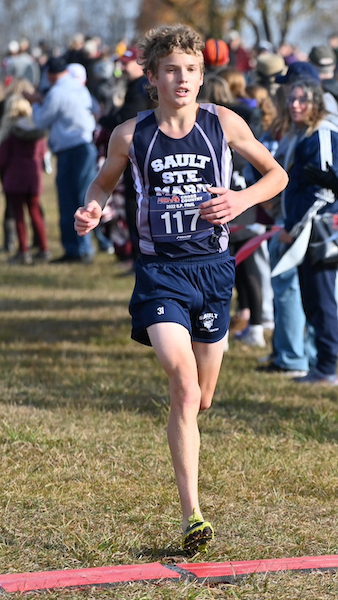 Sault Ste. Marie freshman Gabe Litzner recorded the day’s fastest time, covering the 3.1-mile course in 16 minutes, 41.55 seconds on a sunny and mild day on the Richer farm property, home of the Farmhouse cross country course, near Gladstone. He was followed by Gladstone senior Drew Hughes (16:48.83) and Ketzenberger (16:58.61), also a senior.
Sault Ste. Marie freshman Gabe Litzner recorded the day’s fastest time, covering the 3.1-mile course in 16 minutes, 41.55 seconds on a sunny and mild day on the Richer farm property, home of the Farmhouse cross country course, near Gladstone. He was followed by Gladstone senior Drew Hughes (16:48.83) and Ketzenberger (16:58.61), also a senior.
“I tried to lay back for two miles, then I tried to reel people after that,” said Litzner, who made his move approximately 400 meters after the two-mile mark. “At that point I felt real good and thought to myself, ‘I have a chance to win this.’ I ran a 16:30 at Rudyard (on Oct. 15) which gave me a lot of confidence. Our team also did real well. I think this will motivate us.”
This marked the first time Hughes broke 17 minutes in a U.P. Final.
“I’m happy with the way everything went,” he said. “I’m glad I got into the 16s. It has been fun running with everybody. I’m happy with how my four years of high school cross country have gone. I set a lot of goals and achieved nearly all of them.”
Freshman Peter Argeropoulous was fourth for Marquette, with sophomore Chase Thomsen sixth, senior Colin VanderSchaaf seventh and junior Cullen Papin ninth.
Division 2
Painesdale Jeffers grabbed the top three places and retained its Division 2 title with 27 points, followed by Ishpeming with 70 and Ironwood with 78.
“We came in with a real solid game plan and were as ready as we could be,” said Jeffers coach Sam Kilpela. “We really worked on pace in practice and came through exactly where we should be.
 “Going 1-2-3 was unexpected. Brit (Heinonen) had a real bad cramp halfway through the race, but still ran a solid race. This was just a rewarding day. The guys are talented. They work together.”
“Going 1-2-3 was unexpected. Brit (Heinonen) had a real bad cramp halfway through the race, but still ran a solid race. This was just a rewarding day. The guys are talented. They work together.”
Senior Tavin Larson was crowned champion for the first time in 17:43.83. He was followed by freshmen Landon Larson (17:44.4) and Cameron Anderson (17:53.34).
“This was my best race of the year,” said Tavin. “Once I got into first place (after the first mile), I tried to hold off my brother. Our top four runners always run as a pack, and we’re always within 30 seconds of each other. Our top runner from last year missed this season with a broken leg, but we have two freshmen who are fast. We have a lot of good middle school runners coming up. The future looks bright.”
Ironwood coach Ben Schmandt said he was pleased with his team’s effort.
“We kind of finished where we expected,” he added. “The guys left it all on the course. They worked hard all year long and had a nice finish. We’ll keep working at it. We’ll miss our seniors. Hopefully, we’ll keep working hard and stay in competitive mode.
Division 3
Stephenson captured the Division 3 crown with its first Finals title since finishing a streak of three straight in Division 2 in 2012. The Eagles were Division 3 runners-up last season.
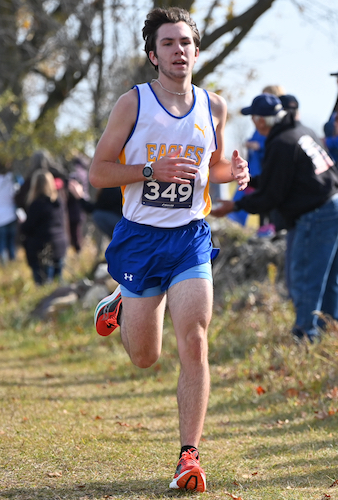 The Eagles scored 77 points and Engadine edged Republic-Michigamme 86-89 for its first runner-up trophy.
The Eagles scored 77 points and Engadine edged Republic-Michigamme 86-89 for its first runner-up trophy.
“We ran a lot of races with Munising, and they really pushed our boys,” said Eagles coach Kate Kuntze. “I’m really proud of our boys. They performed on a day we really needed them to. In D-3 there’s so many schools without full teams. We couldn’t settle for passing just one runner. The weather was perfect and the boys came in with a good mindset.”
Dollar Bay senior Amos Norland was the top individual finisher in a school-record 16:44.18, followed by Pickford’s Hayden Hagen (18:00.14) and Munising sophomore Trevor Nolan (18:04.1).
“Getting a lot of sleep and eating healthy were keys in the last two days,” said Norland. “I did 1-K repeats in practice and tried to keep a steady pace today. I got the school record by 21 seconds, which was unexpected for sure. I knew I had a chance, but I thought I’d get it by just a couple seconds.”
Seniors Griffin Brown in fourth and Jacob Ross in ninth set the pace for Stephenson.
PHOTOS (Top) Gladstone's Drew Hughes (27), Marquette's Carson VanderSchaaf (78), Gladstone's Aaron Hughes (26), Sault Ste. Marie's Gabe Litzner (117) and Cody Aldridge (112), and Negaunee's Judge Anderson (98) lead the start of Saturday’s Upper Peninsula Division 1 Final. (2) Litzner crosses the finish line first in the D1 race. (3) Painesdale Jeffers’ Tavin Larson (186) wins Division 2 with freshman brother Landon Larson (185) a close second. (4) Stephenson's Griffin Brown races to a fourth-place finish in Division 3. (Photos by Cara Kamps.)
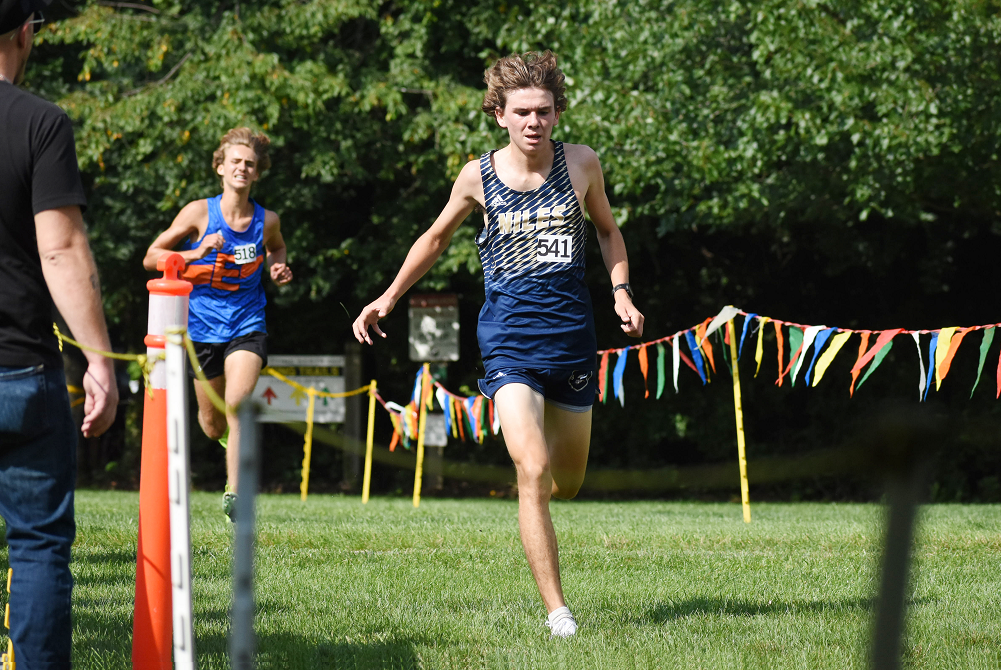
Speedy & Skilled, Krueger Again Boosting Niles' Cross Country, Tennis Teams
By
Scott Hassinger
Special for MHSAA.com
October 3, 2023
NILES – On any autumn weekday afternoon, Aiden Krueger can be found using his legs to carry him across the campus of Niles High School.
 After cross country practice, the Vikings' senior literally runs over to the tennis courts to work out with the boys tennis team.
After cross country practice, the Vikings' senior literally runs over to the tennis courts to work out with the boys tennis team.
The fall dual-sport athlete has managed to make a significant impact on both programs during his career at Niles.
In cross country, Krueger is a two-time Lower Peninsula Division 2 Finals qualifier and recently broke a long-standing school record in the 5,000-meter (3.1 mile) race.
In Saturday's Berrien County Meet held at Lake Township Park in Bridgman, Krueger's first-place time of 15:55.5 broke Jeff Ort's 33-year record of 16:05 set in 1992.
Breaking the school record was one of two main goals that Krueger, the Vikings' No. 1 runner, and his head coach Tony Todd and assistant coach Jason Todd set prior to the start of the 2023 season.
"It felt great to take down a school record that's been there for so long. On the day of the Berrien County Meet, my coaches and I talked about how I felt that day. They could tell I was feeling really good, so we went for it," Krueger said. "I felt great the entire race, and my body responded very well. My coaches were at the one and two-mile mark to let me know where I was at. I was able to squeeze out a record time, and the feeling of being able to share that moment with my family, coaches and teammates was unmatched. It's a day that I'll cherish for a very long time."
While Krueger always has shown a natural ability for running, he soon realized he needed to increase his offseason training in order to reach his career goals.
"Aiden is naturally gifted. He broke the eighth-grade two-mile record in cross country, so we knew he was going to be a special runner. What we didn't know at that time was how strong of a runner he was in terms of his mental preparedness. He was a quick study coming into the program as a freshman, but natural ability will only take you so far. There is a lot more that goes into becoming an elite distance runner," Tony Todd said.
Despite running very little over the summer prior to the start of his freshman season, Krueger still managed to post some respectable times in the 17:20s, but he narrowly missed qualifying for the Finals.
Following a couple of years of running track & field for Niles, and with running higher mileage the last three summers, Krueger feels he has prepared himself well enough to attain his ultimate goal of earning all-state (Top 30) at this year's Finals on Saturday, Nov. 4, at Michigan International Speedway.
"Aiden isn't afraid of hard work. He ran 55 miles per week this summer, and up to this point we haven't backed him off from that number very much," said Niles' head coach. "We've been concentrating on consistency, and once the state meet is about a month away we'll start him on more speedwork."
Krueger, a three-time all-Wolverine Conference and all-Regional runner as well, has the opportunity to graduate as one of Niles' most decorated athletes ever with 14 varsity letters.
Well-respected by his teammates, Krueger was selected as one of the Vikings' team captains this fall.
"Aiden is a very positive person and is always encouraging his teammates," said Niles' head coach.
Entering Tuesday's Wolverine Conference tri-meet in Sturgis with the host Trojans and Otsego, Krueger hadn't lost a league race yet and finished first individually in five of Niles' first eight meets. He ran 16:40 or better in five of those meets as well.
As the season progresses and Krueger prepares for this weekend's prestigious Portage Invitational, he knows what he has to do to reach those goals.
"Right now it's real important for me to get out fast and get into a good position so I can figure out when exactly I need to sit back and when I need to move up," Krueger said.
"As we reach the bigger meets like conference and Regionals, there are a lot of good runners. My coaches help me familiarize myself with who is at those races and who I need to go out and run with. I thank God who gave me the ability to run, along with the support of my coaches and family."
Krueger plans to end his competitive running career once he has finished high school. His parents, Robert and Korrie Krueger, own Milano's Pizza in Niles, and his future plans are to help out with the family business or attend trade school.
Krueger didn't play tennis as a freshman, but made an immediate impact as a doubles player the last two years on the varsity. Since cross country is Krueger's priority sport, Niles head boys tennis coach Jill Weber felt it would be more beneficial for the team if he played singles this fall.
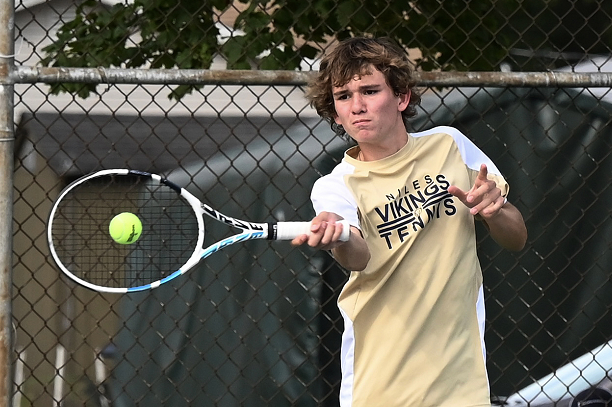 "Aiden was real receptive to the change. As coaches, we just thought it would be easier to replace him in singles rather than have a doubles partner be forced to play with someone they weren't familiar with," said Weber, who has coached the Niles boys team the last 18 seasons and the girls squad for 20 years.
"Aiden was real receptive to the change. As coaches, we just thought it would be easier to replace him in singles rather than have a doubles partner be forced to play with someone they weren't familiar with," said Weber, who has coached the Niles boys team the last 18 seasons and the girls squad for 20 years.
Krueger was sporting a record of 13-2 and was undefeated in the Wolverine at No. 2 singles at the end of last week. His only losses came in nonleague matches to Coldwater and Kalamazoo Christian.
"Aiden has an extraordinary work ethic. He works really hard, but at the same time he enjoys it and has fun. He usually only needs two or three games to figure out what he needs to do to win a match," Weber said. "I have so much confidence in him to get the job done."
Weber is amazed at how Krueger juggles his time off the court with school and cross country.
She used Saturday, Sept. 9, as an example of his commitment to both sports.
Krueger started that day competing with the cross country team at the Kalamazoo Loy-Norrix Mini-Meet, a race he won in a then personal-best time of 16:31.4. He then jumped in the car with his parents, who drove him to Mattawan where the Vikings' tennis team was competing in a tournament.
"Mattawan was gracious enough to put Aiden on one of the later courts so he could play all three of his matches once he was finished with his cross country meet," Weber explained.
Krueger won all three of his tennis matches.
"That was a pretty exciting day for Aiden. He just takes it all in stride and isn't a showboat on the court. When he's on the court he has a way of making friends with his opponents and makes good calls and shows good sportsmanship. A lot of people have nothing but good things to say about him," Weber said.
"As far as his ability on the court, Aiden is a very tricky player to figure out and has a lot of weapons. He has a good dropshot, can lob the ball, hit an angle shot or hit an approach shot and draw you out of position."
Krueger is well-respected by his tennis teammates as well.
"Everyone loves Aiden. He likes to joke around, but he truly enjoys every one of his teammates and respects them all equally. He's a good student and had the team over to his house for a team dinner recently," Weber said.
Knowing how important Krueger's senior season of running was to him, Weber spoke with Tony Todd before the year began about his role with the tennis and cross country teams.
"I understood how important running is to Aiden this year. The last thing I want to do is stress a kid out. He's done a nice job for us in tennis, but we're not expecting a great deal out of him. I want him to be able to concentrate on his cross country goals," Weber said.
Krueger's older brother Andrew Krueger played tennis for Niles a few years ago, and that sparked Aiden's interest in the game.
"I participated in some summer tennis camps back when I was in seventh grade. I liked my experience playing doubles the last couple years, but singles is a challenge because you have only yourself to rely on and the court is smaller," Krueger said.
Krueger describes himself as confident on the court, and he considers himself more of baseline player.
"I'm really comfortable on the baseline, and my tennis goals are to just try and finish the year with the best record I can in the conference and help my team do as well as we possibly can," Krueger said.
 Scott Hassinger is a contributing sportswriter for Leader Publications and previously served as the sports editor for the Three Rivers Commercial-News from 1994-2022. He can be reached at [email protected] with story ideas for Berrien, Cass, St. Joseph and Branch counties.
Scott Hassinger is a contributing sportswriter for Leader Publications and previously served as the sports editor for the Three Rivers Commercial-News from 1994-2022. He can be reached at [email protected] with story ideas for Berrien, Cass, St. Joseph and Branch counties.
PHOTOS (Top) Niles’ Aiden Krueger crosses the finish line after winning his race during a home meet this season against Edwardsburg. (Middle) Krueger follows through on a forehand shot during a Wolverine Conference match earlier this season. (Top photo by Scott Novak/Leader Publications. Middle photo by Kelly Sweeney/Leader Publications.)

